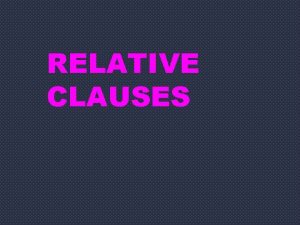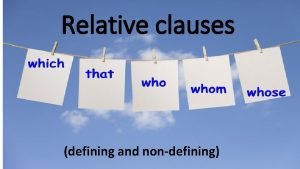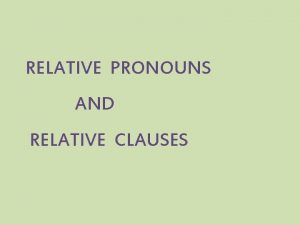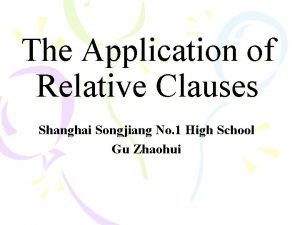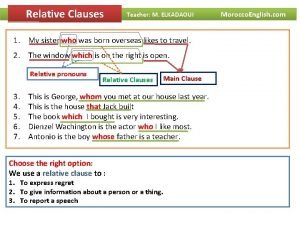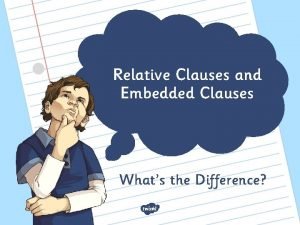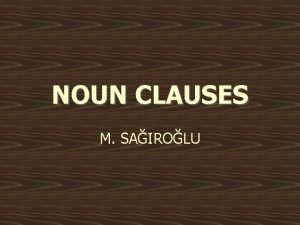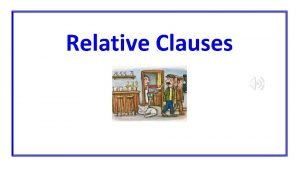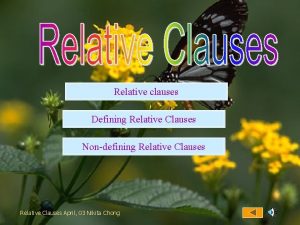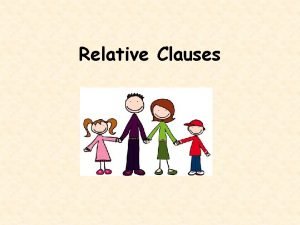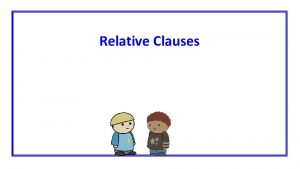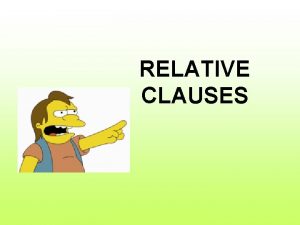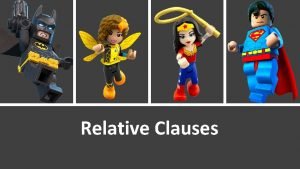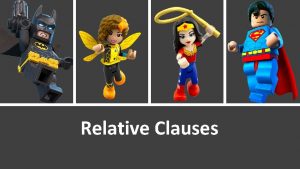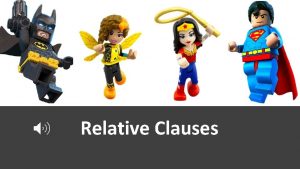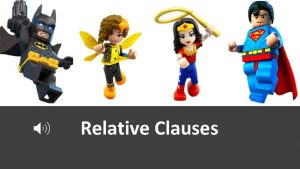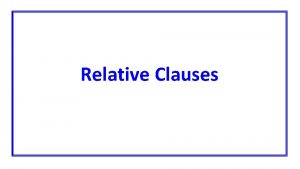RELATIVE CLAUSES DEFINING RELATIVE CLAUSE We use defining













- Slides: 13

RELATIVE CLAUSES

DEFINING RELATIVE CLAUSE We use defining relative clauses to add essential information to a sentence. The clause goes immediately after the noun it describes. “This is the man who sold me the car. ”

n We use relative pronouns: n who, that – for people n which, that – for objects n where – for places n whose – to talk about possession n when, that – for a time n why, that – for a reason n whom – for object pronouns (people)

n He is the man who / that owns this car. n This is the house where I was born. n The girl whose party I went to phoned me.

n We can leave out who, which, that, whose, when the clause is the object of a sentence. “The doctor I spoke to told me not to worry. ” “The man I saw was very rude. ” “Mr Smith is the teacher my son likes best. ”

n We can’t leave out the relative pronoun in a defining relative clause that refers to the subject. “The doctor who treated me told me not to worry. ” “That’s the dog that attacked my children”

n In defining relative clauses why and when, unlike where can be omitted n I'd like to know the reason (why) he decided not to come n BUT! She always had wanted to go to a place where she could speak her native tongue

NON-DEFINING RELATIVE CLAUSE n We use non-defining relative clauses to add non-essential information to a sentence. The clause goes immediately after the noun it describes. If we removed the relative clause, the sentence would still make sense of its own. “Pedro, who is my brother, lives in Astillero. ”

n We use commas to separate a no-defining clause from the rest of the sentence.

n We use relative pronouns: n who – for people n which – for things n where – for places n when – for time n whose – for possession “Santander, where I live, is a beautiful city. ” “My father, who is sixty four, is going to retire soon. ”

n We can’t leave out the relative pronoun in non-defining relative clauses. “John, who is English, helped me write the essay. ”

Complete the sentences with a suitable relative pronoun if necessary n Is that the book _____ you read last month? n Is this the film _____ won three Oscars? n This is the shop ____ they sell Mexican food. n Last summer I met a girl _____ father is a famous lawyer. n An engineer is a person ____ plans, makes or repairs things like machines, roads or bridges. n My neighbour works for a company _______ builds roads. n This is the town _____ my mother grew up.

Complete the sentences with a suitable relative pronoun if necessary n n n n A tin opener is a thing ____ you open things with. Palencia is the city _______ my mother was born. This the company ____ my brother works for. The stage on ____ the new play was performed was very small. I didn’t enjoy the film ____ we saw last night. The sofa on _______ we were sitting collapsed. An air hostess is woman ____ job is to look after people on a plane. Here is the book _____ you have been looking for.
 What is non defining clause
What is non defining clause Relative clauses defining and non defining
Relative clauses defining and non defining Prepositions in relative clauses
Prepositions in relative clauses Defining relative clause meaning in telugu
Defining relative clause meaning in telugu Non-defining relative clauses cümleleri
Non-defining relative clauses cümleleri Defining non defining relative clause
Defining non defining relative clause We can't leave the pronoun out of a clause
We can't leave the pronoun out of a clause Nondefining relative clause
Nondefining relative clause Oraciones con that relative clauses
Oraciones con that relative clauses Defending and non defining relative clauses
Defending and non defining relative clauses Defining relative clause worksheet
Defining relative clause worksheet Embedded relative clause
Embedded relative clause Noun clause relative clause farkı
Noun clause relative clause farkı Subordinate clause examples
Subordinate clause examples






